 |
 |
|
 |
Federal omnibus bill provides extra $132 million for Minnesota transportation
|
 |
 |
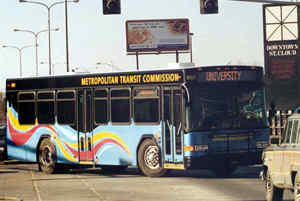 |
St. Cloud’s Metro Transit bus system will benefit from $132 million
in transportation-related appropriations from the federal Omnibus Funding
Bill for fiscal year 2003. Photo by David Gonzalez
|
The Omnibus Appropriations Agreement for federal fiscal year 2003 recently
approved by Congress allocates funding to the states not ordinarily contained
in appropriations made under legislation such as the Transportation Equity Act
for 21st Century or other federal funding programs. The agreement
will bring an additional $132 million in transportation funding for Minnesota.
Congressional appropriations will be used in Minnesota for scores of transportation-related
projects ranging from $60 million for the Hiawatha LRT project to $1 million
to build a park-and-ride facility in Robbinsdale.
Other projects that received funding include $500,000 for transit facilities
in St. Cloud, $500,000 for bus and facility improvements for the Duluth Transit
Authority and $1.5 million for the Hwy 55 corridor preservation project from
I-494 to Annandale.
Nationally, funding for transportation-related needs remained at the fiscal
year 2002 level of $31.8 billion, but was $8.56 billion more than requested
by the Bush Administration. The administration’s proposal was based in part
on the downturn of receipts into the Federal Highway Trust Fund, the primary
source of federal transportation funding, said Dan Krom, director of federal
affairs, Government Relations.
Funding was also approved for Metro Transit, Greater Minnesota highway projects,
Twin Cities freeway improvements, de-icing facilities and the Minneapolis-St.
Paul International Airport and the Minnesota Guidestar Intelligent Transportation
System program at the University of Minnesota.
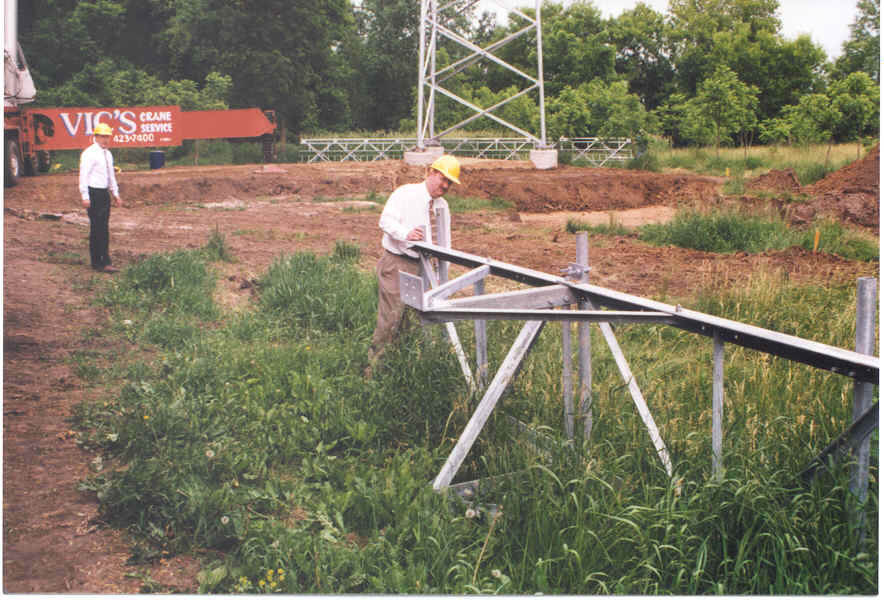 |
Andy Terry, director, Electronic Communications, helps set up an 800
Megahertz radio system tower. Staff photo
|
The Minnesota Guidestar Program, a cooperative program involving Mn/DOT, the
Center for Transportation Studies and the Humphrey Institute, received $9.1
million to continue developing new technologies. Guidestar programs include
satellite bus tracking, the statewide Advanced Traveler Information System and
message boards to manage traffic on 250 miles of freeways in the Twin Cities
and on Greater Minnesota highways.
The Metropolitan Radio Board received a $1.5 million allocation to continue
its development of the 800 megahertz digital radio communications system that
links police, firefighters, first responders, transit workers, hospitals, the
State Patrol and Mn/DOT.
The funding bill also includes $15 million in addition to the Minnesota projects
for aircraft noise reduction research that will be conducted by the Federal
Aviation Administration and the National Aeronautics and Space Administration.
Members of Minnesota’s congressional delegation announced the appropriations.
"The support we receive from elected officials in Washington is essential
to provide federal funds necessary to address a growing backlog of transportation
needs in Minnesota," Krom said.
By Craig Wilkins
|
back

|
 |
Legislative proposal seeks interstate status for Hwy 62/I-35W commons area |
 |
 |
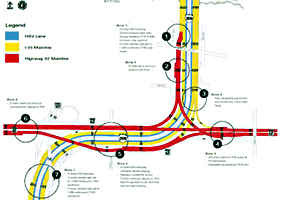 |
The Hwy 62/I-35 commons area carries traffic volumes similar to the
Twin Cities Metro area's interstate freeways.
|
Mn/DOT’s legislative initiatives for 2003 session of the Minnesota Legislature
include proposals related to moving utilities in design-build projects and treating
the Hwy 62/I-35W commons area as part of the interstate system for the purpose
of obtaining municipal consent.
Other proposals include creating an additional northern zone for managing winter
load increases and turning back parts of two state highways in two counties.
Mn/DOT seeks treatment of the Hwy 62/I-35W Crosstown commons area in Richfield
and Minneapolis as part of the interstate highway system in order to obtain
municipal consent.
The department would still be required to seek the cities’ approval on rebuilding
the commons area, but the authority to make final decisions for the project
would rest with the Mn/DOT commissioner.
Mn/DOT proposes legislative approval to develop a process for relocating utilities
in design-build project areas. The proposal seeks methods to ensure continuity
of utility service, perform utility relocation through the design-build project
contractor, avoid project delays due to utility work, and when feasible, provide
a replacement easement for the utility company.
The proposal to add one or more winter load increase zones stems from a study
which found that substantial temperature differences that occur in northern
Minnesota could change the dates when increases are allowed.
Minnesota now has six spring weight restriction zones. Purpose of the zones
is to limit the damage caused by heavy trucks when thawing conditions weaken
roadbeds. This proposal stems from a legislatively directed study conducted
by Mn/DOT.
Another initiative, the turnback of highway sections will reduce maintenance
and administrative costs. Trunk highway segments totaling 19 miles will be turned
over to Nobles and Redwood counties’ jurisdiction.
The Mankato District will transfer the entire 14-mile length of Hwy 266 from
Wilmont to Worthington in Nobles County. Doug Haeder, district state aid engineer,
said the transfer is being proposed because Hwy 266 doesn’t connect other state
highways.
In Redwood County, the Willmar District will transfer jurisdiction of a five-mile
section of Hwy 273 that extends between Hwy 19 and Belview to the county.
By Craig Wilkins
|
back

|
 |
Employees’ suggestions could save money for state |
 |
 |
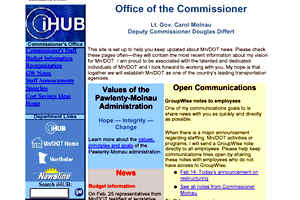 |
The Commissioner's Web page includes links to the cost cutting submission
form, along with other useful information.
|
Encouraged by Lt. Gov./Commissioner Carol Molnau’s invitation to find ways
to cut costs and improve Mn/DOT’s efficiency, employees during the past six
weeks have offered hundreds of suggestions for doing just that.
The cost-savings ideas fall into several categories, including office management,
construction and contract management, personnel management, building operations,
revenue generation and organizational change. They range from eliminating take-home
state vehicles to having employees reduce their work hours to regulating temperatures
and lighting in buildings more efficiently.
"I’ve been impressed by the extraordinary response employees have shown in
identifying ways to save tax dollars," Molnau said. "The state’s projected
budget deficit is too great for just a handful of policymakers to come up with
solutions. We all need to find ways to contribute ideas—no matter how small—to
make the most of our budget."
Some of the ideas already being implemented include:
-
Assembling a group to draft a policy determining who is eligible to take
a Mn/DOT vehicle home
-
Implementing an electronic document management system to ensure documents
are archived digitally versus more expensive hard copy storage
-
Reducing unnecessary expenditures and spending on promotional items
-
Limiting travel to conferences and meetings
-
Reducing year-end spending by reallocating budget balances at the end of
a biennium to construction programs
-
Reviewing Mn/DOT's information technology practices to create greater efficiencies
-
Creating a policy that focuses on using e-mail instead of paper for document
sharing
-
Reviewing manager positions
Suggestions about specific department operations will be forwarded to the appropriate
division director for action, while ideas that are outside Mn/DOT’s authority
(e.g., health insurance or contract issues) will be forwarded to the appropriate
agency.
To see a summary of the suggestions that have come in or to submit additional
ideas, check out the Commissioner’s Web
site. Click here if you would like to make
a cost-saving suggestion.
Star Tribune requests copies of employees’ suggestions
Reporters from the Star Tribune, citing the state’s Data Practices
Act, recently requested access to the cost-saving suggestions submitted
by Mn/DOT employees. After consulting with Mn/DOT legal counsel and
the Attorney General’s staff, the department was told that this information
would have to be made available because the law classifies information
of this sort as public.
"At the time ideas were solicited, I was under the understanding
that all cost saving ideas could remain anonymous," said Lt. Gov./Commissioner
Carol Molnau.
"My initial response was to refuse the reporters’ request because
of the confidential way Mn/DOT employees were encouraged to submit their
ideas. They trusted their ideas would remain anonymous, and I fully
expected the same," Molnau said. "I apologize for this unfortunate
situation and for being unable to meet employees’ expectations."
The Office of Communications and Public Relations is available to assist
employees responding to any media inquiry.
|
|
back

|
 |
Staff begins budget rounds with Legislature |
 |
 |
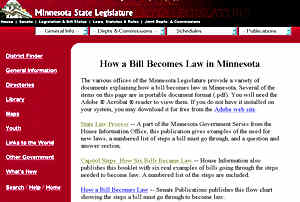 |
|
There are a number of Web pages, such as the one pictured
above on the Legislature's site, to help the public learn about the legislative
process.
|
In testimony before the House Transportation Finance Committee
this week, Mn/DOT staff presented several options for meeting a portion of the
$84 million budget reduction the governor has proposed for transportation for
FY 2004-05.
Included in Mn/DOT’s presentation were proposed reductions
for transit ($400,000); freight, railroads and waterways ($350,000); commercial
vehicles ($750,000) and airports ($846,000). See Lt. Gov./Commissioner Carol Molnau’s memo for more information about Mn/DOT’s budget reduction proposals, which
include options that:
- Reduce administrative costs
- Reduce spending/service in maintenance and operations, such as snow
and ice, rest areas, etc.
- Manage inventory and equipment more effectively
- Consolidate and reduce investments in information technology
- Use attrition and reduced spending to minimize layoffs
As Mn/DOT works through the legislative process, a number of options
for budget reductions will be discussed during the weeks ahead as legislators
grapple with a projected $4 billion-plus state deficit for FY 2004-05.
Although the numbers reported in the March 5 Star Tribune mention specific
program and position cuts, these numbers are still at the proposal stage. They
will likely fluctuate based on a number of factors, including the governor’s
transportation funding package (to be announced next week), and the Legislature’s
final budget, which is weeks away from approval.
For more information about budgets, follow these links:
Budget process
Minnesota’s FY 2004-05 budget
Background and fact sheets
Department of Finance
For more legislative information, visit Mn/DOT’s Government Relations’ site and the Legislature’s
page on How a Bill
Becomes a Law.
|
back

|
 |
First Hiawatha Line LRT vehicle leaves Mexico for Minneapolis |
 |
 |
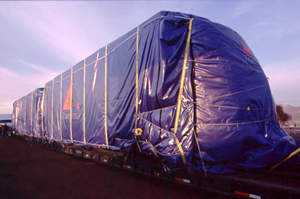 |
Under for wraps now, the first Hiawatha Line car is nowheading toMinneapolis.
|
The first vehicle for the Hiawatha light-rail line is on its way to the Twin
Cities. It left Mexico on Feb. 24, and will travel 2,024 miles to its new home
in Minneapolis. It's scheduled to arrive in mid-March. For daily updates on
the vehicle’s progress, visit
http://www.dot.state.mn.us/metro/lrt/.
The 94-foot-long rail vehicle, manufactured by Bombardier Transportation Systems,
was wrapped in several layers to protect it from damage during the trip. Carrying
the extra-long cargo is a 180-foot trailer that has steerable rear wheels to
allow it to turn corners.
It will make its way from Bombardier's manufacturing facility outside Mexico
City, cross the U.S. border at Columbia and stay on I-35 through Texas, Oklahoma,
Kansas and Iowa to Minneapolis.
Upon arrival, the vehicle will spend several weeks inside the rail facility
for systems testing. Then it will be seen regularly along a one-mile test track
adjacent to the facility. Metro Transit has 22 vehicles on order.
By Josh Collins
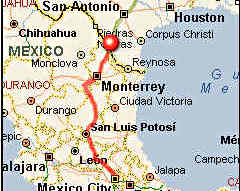 |
It all began here in Mexico where the vehicle construction takes place.
|
Metro’s Newsline also carried a story about this in the Feb. 24 edition. Click
here to read the story: http://ihub.metro.dot.state.mn.us/newsletter/.
Click here to visit Metro’s and other district newsletters:
|
back

|
 |
Detroit Lakes’ DE fields tough questions from employees during first ‘Lunches
with Lee’ |
 |
 |
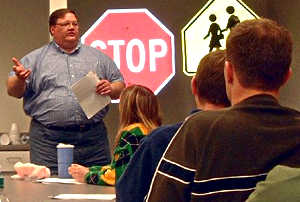 |
Detroit Lakes District Engineer Lee Berget meets with district employees
to answer questions about reorganization and other topics. Photo
by Pam McLeod
|
Lee Berget, district engineer, Detroit Lakes/District 4, kicked off the first
"Lunches with Lee" event on Feb. 19 at the Detroit Lakes headquarters
office. More than 40 employees joined him for a potluck lunch as he reviewed
information regarding the status of Gov. Pawlenty’s proposed budget and policy
highlights.
Employees asked questions regarding how the budget impacted the district as
well as layoffs, hiring and budgets decisions. Berget also talked about Mn/DOT’s
administrative changes, the proposed $42 million per year cuts to transportation,
and the governor’s emphasis on decreasing administration and overhead costs
while preserving the construction program.
In the next few weeks, Berget will hold more "Lunches with Lee" throughout
the district to give employees the opportunity to ask questions and get administrative
and budget information.
"The employees who attended really appreciated the opportunity to meet
with Lee and ask questions," said Pam McLeod, public affairs coordinator.
"It shows that he’s interested in what is on people’s minds and is trying
to answer any questions they might have."
Last month, Metro’s then-Division Engineer Bob Winter, now division director,
District Operations Division, fielded similar questions from Metro employees
during the January installment of "Discussions with Bob." Metro has
conducted these brown-bag lunches since the mid-1990’s, with former former Division
Engineers Chuck Siggerud and Dick Stehr holding "Conversations with Chuck"
and "Discussions with Dick" respectively.
Mn/DOT Newsline carried a story about Winter’s session in the Feb.
6 Newsline.
By Pam McLeod
|
back

|
 |
New Mn/DOT organizational chart reflects governor’s goals |
 |
 |
There are fewer layers of management in Mn/DOT now after recent changes to
the agency’s organizational structure. Changes come with specific goals and
expectations set out by Gov. Tim Pawlenty.
"Our charge is to increase accountability to Minnesota's taxpayers and
to develop ways to deliver the construction program faster and more efficiently,"
Lt. Gov./Commissioner Carol Molnau said. "The governor asked Mn/DOT to
realign its spending priorities—with a significant focus on decreasing administrative
and overhead costs—to achieve a budget reduction goal of $42 million per year."
"The reorganization also brings similar functions together to eliminate
redundancy and increase coordination—all with a goal of accelerating the delivery
of Mn/DOT’s construction program," Molnau said.
Next on the horizon, Molnau said, is a new transportation funding package generated
by the governor's direction to focus on transportation enhancements that help
Minnesotans travel more safely and efficiently. The governor is expected to
announce his proposal next week.
The new organization chart is now available on Mn/DOT’s Web site at:
http://www.dot.state.mn.us/information/orgchart.html
By Marsha Storck
Keep up with Mn/DOT News and Views
Some of the media news coverage of Mn/DOT comes in response to news
releases from Mn/DOT. News releases of statewide interest are on the
Web site. Follow the links below, or visit the Mn/DOT home page, go
to "News and Views" (on the viewer’s left side of the screen),
and then "News releases."
These are some recent news releases:
|
|
back

|
 |
Hwy 23 to expand to handle traffic congestion in southwest Minnesota |
 |
 |
 |
Project engineer Paul Jurek answers questions about thenow-approved
widening of Hwy 23 in southwestern Minnesota.
|
The first phase of construction that will transform Hwy 23 from a two-lane
road into a divided four-lane highway between Hwy 71 just north of Willmar and
New London begins this spring. The additional lanes should help manage increasing
traffic and reduce the frequency of crashes, according to Mn/DOT Willmar/District
8 officials.
The $37.9 million highway project involved years of coordination with affected
communities such as Spicer and New London. Staff worked with local governments,
citizens’ groups and business owners of adjacent land to gain support and trust.
Construction should be complete in 2004, said Paul Jurek, project engineer,
Marshall office.
The project generated substantial controversy, especially in Spicer where some
residents expressed concern about traffic levels, safety and runoff into area
lakes including Green Lake, one of the region’s primary tourist attractions.
Early in the project, the district committed to a no-net increase in the flow
of phosphorus and other nutrients in area lakes.
"By working together, the project has not only met this goal but decreased
nutrient loading below existing levels," said Todd Broadwell, assistant
district engineer for technical resources.
"We recognize we need to serve their purposes as well as mobility and
economic growth," said Patrick Weidemann, district planning director. "We
were able to incorporate those needs in the plan without compromising the community’s
integrity. Now I believe we have a very good product."
Wide community participation in the planning process helped create support
for the project.
"Ownership lies not only with Mn/DOT but with everyone who participated,"
said Broadwell. "We are grateful to the individuals and groups who contributed
to the success of this project."
Weidemann added: "Hwy 23 is the main economic driver in the region. It
connects the Willmar region to the interstate system and supports business growth
throughout the corridor."
The road is also a medium-priority interregional corridor serving as a major
route from I-90 in southwestern Minnesota linking cities such as Pipestone,
Marshall, Granite Falls, Willmar and St. Cloud. Long-range forecasts indicate
heavy population growth and increased commuter traffic.
By Craig Wilkins
|
back

|
 |
Snow gates go up on I-35 and I-90 in three more counties |
 |
 |
In order to better control traffic on I-35 and I-90 during severe weather,
the Rochester District installed gates on 13 entrance ramps to the freeways
in Steele, Freeborn and Mower counties.
The manually operated gates will prevent motorists from entering the freeway
during heavy snowstorms and other severe weather conditions
The gates on I-35 begin with Steele County Highway 26 near Owatonna and extend
to Freeborn County Hwy 5 just north of the Iowa border. The I-90 gates are installed
on the 28th Street and the Hwy 105 entrances to the freeway, both in Austin.
Use of the gates improves traveler safety and reduces the costs of winter snow
removal by minimizing the potential for stalled vehicles’ hampering snowplowing
operations.
"Heavy snow or whiteout conditions force us to close southbound I-35 south
of Owatonna every year," said Wes Smith, Owatonna area maintenance superintendent.
"In the past, we paid local police and fire departments to keep the ramps
closed while we plowed the freeway. Now a closed gate can do that for us at
less cost."
By Brian Jergenson
For more information about Rochester/District 6’s use of the freeway gates,
visit the news clippings for March 1-3 at: http://www2.dot.state.mn.us/clips/dailyclips/html/03/mar/3.html
|
back

|
 |
State agencies pool HR resources to help Mn/DOT with job classification study
|
 |
 |
Beginning March 17, a team of human resources professionals from several state
agencies will help conduct a formal classification study of all management positions
within Mn/DOT.
This four-month-long study will require that managers review and update their
position descriptions to reflect changes to their duties and responsibilities.
Staff from Mn/DOT’s Office of Human Resources, the Department of Employee Relations
and other state agencies will develop recommendations about which job classifications
best match managers’ duties.
In a March 3 memo to managers, Lt. Gov./Commissioner Carol Molnau said that
these position descriptions would serve as the primary source of job evaluations.
The study will end July 14.
"The goal of the study is to have accurate, definitive information on
every management position within this department," Molnau said.
Molnau said that some managers, with assistance from HR staff, may be asked
to provide formal presentations to the study evaluation team.
For more information or to request assistance with development of position
descriptions, contact your Human Resources representative.
By Marsha Storck
|
back

|
 |
|
 |



